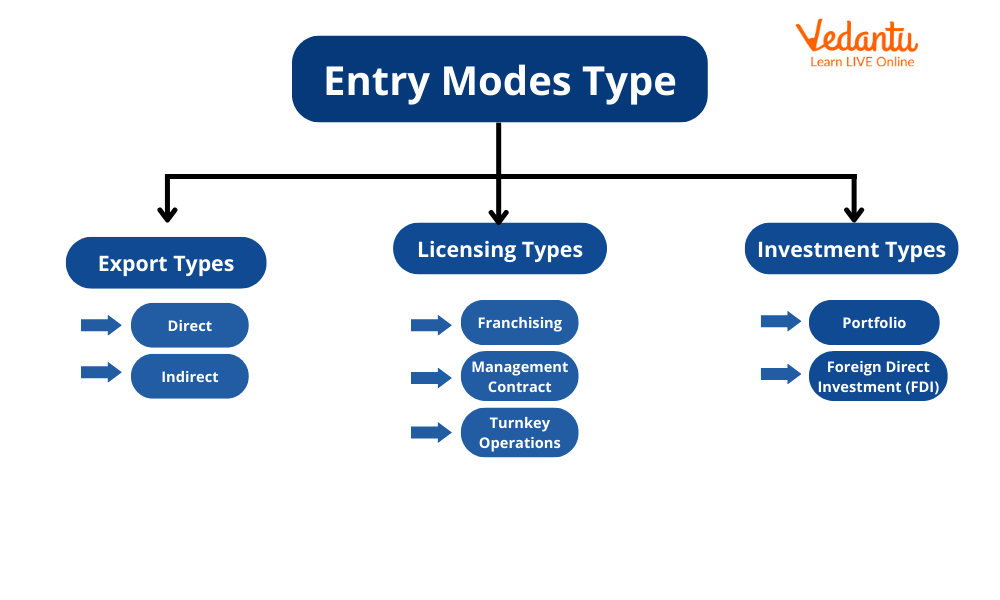




What does International Business Mean?
The term "international business" refers to a wide range of activities undertaken by many organisations to gain access to foreign markets; however, it is not widely used because the average person cannot identify the activities as being part of international business. There are several approaches that businesses looking to do business internationally can take, which are referred to as modes of international business.

Modes of Entering International Business
Why Should Companies Expand Globally?
A truly international corporation has a globally distributed supply chain. Even if a global supply chain has flaws that are frequently beyond a company's control, there are various reasons why a company might want to explore foreign markets.

Reasons Why Companies Should Expand Globally
Companies Usually Decide To Enter International Markets For The Following Reasons:
1. Determine Which Markets Will Be More Profitable
This is why many domestic companies are expanding into international markets. A global market's purchasing power may increase, resulting in higher earnings for the same products. This excludes the initial go-to-market costs associated with entering that foreign market.
2. Revenue Growth
One of the primary benefits of globalisation is an increase in revenue. International marketing allows you to reach a larger audience than your local market, which increases sales more effectively. Global expansion is required for business growth that is not limited to the typical revenue your local market can provide for your organisation.
3. Savings Increase
While going global increases profit potential, it also allows for lower expenses. Doing business abroad is typically less expensive because you can cut production costs in countries with lower wages. Because of the disparity in minimum wages around the world, you may have to pay your overseas employees less in salary than your local employees. Apple, for example, outsources manufacturing to China to save money on labour.
Different Modes of Entering International Business

Types of Entry Modes in International Business
Below are the different modes of international business -
1. Exporting
The traditional mode of entering into international business is Exporting. Exporting is the simplest way to get started in foreign business. As a result, most businesses begin their global expansion in this manner. The act of selling goods and services produced domestically in other countries is known as exporting. Exports are classified into two types:
Direct exports are transactions in which a company sells its products directly to a buyer in another country. At this company, you will gain firsthand market knowledge.
Indirect exports include hiring a third party's skills to facilitate the transaction. The fee is the amount charged by the intermediary for its services.
2. Licensing
In this mode of entry, a manufacturer from the home country rents the right to their intellectual properties, such as technology, copyrights, brand names, and so on, to a manufacturer from a foreign country. To obtain the license, you must pay a set fee. Lessees are manufacturers who lease, and licensees are manufacturers from the country that receives the license. Essentially, the licensee is purchasing another company's assets (know-how or R&D). The licensor may grant these rights non-exclusively to a single licensee or exclusively to one or more licensees.
3. Franchising
A separate company known as the franchisee operates under the brand of a different organisation known as the franchisor in this model.
Because of franchising, a franchisee can use a name, procedure, method, or trademark. Furthermore, the franchisor company provides raw materials, assists the franchisee with business operations, or does both.
4. Management Contracts
A company essentially rents out its knowledge or know-how to a government or business in the form of individuals who enter the foreign setting and manage the business under management contracts and do contract manufacturing.
This strategy of entering international markets is frequently used with a new facility after a company has been seized by the national government or when a business is experiencing difficulties.
5. Foreign Direct Investment
A corporation can enter a foreign market through foreign direct investment by investing significantly there. Foreign direct investment can be used to enter the global market through mergers and acquisitions, joint ventures, and greenfield investments. This strategy is appropriate when there is sufficient demand, market size, or market growth potential to justify the investment.
6. Joint Endeavors
A joint venture is one of the preferred ways to enter the global market for companies that don't mind sharing their brand, knowledge, and expertise.
Companies that want to expand into international markets can form joint ventures with local companies in those markets, in which both joint venture partners share the benefits and risks of the business.
The investment, costs, profits, and losses are allocated to the two corporate units in accordance with a predetermined ratio.
This method of entering the global market is suitable for countries where the government prohibits 100 percent foreign ownership in certain industries.
Case Study - Different Modes of Entering International Business
In 1994, the corporation began offering free coffee to visitors in several Beijing hotels to promote the Starbucks brand. This campaign demonstrated that their goods had a sizable market in China, particularly among foreigners. People in the area who attempted to emulate Western culture expressed a desire to drink coffee. Western brands and goods enticed the younger generation as well. These factors prompted Starbucks executives to investigate and comprehend the Asian country's economic environment.
Even though Starbucks encountered numerous challenges when attempting to enter the Chinese market, by 2012, they had successfully expanded their business into over 20 large or medium-sized Chinese cities, with over 560 stores opened. The incredible achievement is due to meticulous marketing analysis and various marketing methods used at various times. These strategies typically refer to joint ventures and license agreements as two distinct methods of entering international markets.
Conclusion
So, above are the methods of entry into foreign markets. Before entering the global market, the company must make a critical decision regarding its operational business plan. The best international business model should be selected based on the company's expansion and diversification requirements. The company's ability and willingness to devote resources, the desired level of control, the level of risk the company is willing to accept, the level of competition, the calibre of the infrastructure, and other factors must all be considered.
FAQs on Modes of Entering International Business
1. What are the different modes of entry in international business?
Companies have several options when expanding into foreign markets. The main modes of entry in international business include exporting, licensing, franchising, joint ventures, and wholly owned subsidiaries. Each method offers different levels of control, risk, and investment. For instance, exporting usually involves the least risk, while owning a subsidiary requires significant commitment. Choosing the right entry mode depends on a company's goals, resources, and market conditions. By understanding these options, businesses can select the most effective strategy for their international expansion and reduce the risks of entering new markets.
2. What are the 5 international business strategies market entry mode?
Companies can choose from five main market entry strategies when entering international business. These methods vary in terms of investment, control, and risk:
- Exporting: Selling products to foreign markets from the home country.
- Licensing: Allowing a foreign company to manufacture and sell a firm's product.
- Franchising: Granting rights to a foreign partner to operate under the company’s brand and processes.
- Joint Venture: Partnering with a local business to share ownership and resources.
- Wholly Owned Subsidiary: Establishing a new, fully owned company in the target country.
3. What are the five common international expansion entry modes?
When expanding internationally, businesses usually select one of five common entry modes. These are:
- Exporting (direct and indirect): Selling goods from home country to another market.
- Licensing: Allowing another company to use your intellectual property.
- Franchising: Letting a foreign entity use your business format and brand.
- Joint Ventures: Combining resources with a local business partner.
- Wholly Owned Subsidiary: Setting up a company that is entirely owned by the parent firm.
4. What are the 4 approaches to international business?
There are four main approaches companies use for international business:
- Ethnocentric: Using the same strategies and products as in the home country.
- Polycentric: Adapting products and management to fit each local market.
- Regiocentric: Standardizing within a region but adapting between regions.
- Geocentric: Integrating a global perspective, combining the best practices from around the world.
5. How does exporting work as a mode of entry into international markets?
Exporting involves selling goods or services produced in one country to customers in another country. It is often the simplest and least risky method to start international business, as it usually doesn’t require major investments abroad. Companies can export directly to buyers or use intermediaries, such as agents or distributors, who manage sales overseas. While exporting lets firms test foreign markets with minimal investment, it may also involve challenges like shipping costs and import regulations. Successful exporters carefully research target markets and ensure they comply with international trade rules.
6. What are the advantages and disadvantages of licensing in international business?
Licensing is an entry mode where a company allows a foreign business to use its technology, brand, or product for a fee. This can be an attractive strategy since it requires low investment and spreads risk. However, it also carries some disadvantages.
- Advantages: Low cost, minimal risk, rapid market access, and the ability to reach new markets without heavy investment.
- Disadvantages: Limited control over licensee operations, risk of intellectual property misuse, and potential creation of competitors.
7. Why might a company choose a joint venture as its entry mode?
A joint venture involves forming a new business with a local partner in the target market. Companies often choose this entry mode to combine resources, knowledge, and market access. Joint ventures offer several benefits such as shared risks and local expertise, but they also involve shared profits and possible management conflicts. For example, in markets where government regulations require local partnerships, joint ventures become a practical choice. This mode allows firms to adapt more effectively while navigating cultural and legal barriers in international business.
8. What factors should be considered when selecting a mode of entry into international business?
Selecting the right mode of entry is a key decision in international expansion and requires consideration of several factors. These include:
- Market potential and competitiveness
- Investment costs and resources available
- Level of risk the company can accept
- Degree of control desired over operations
- Legal and regulatory requirements in the target country























